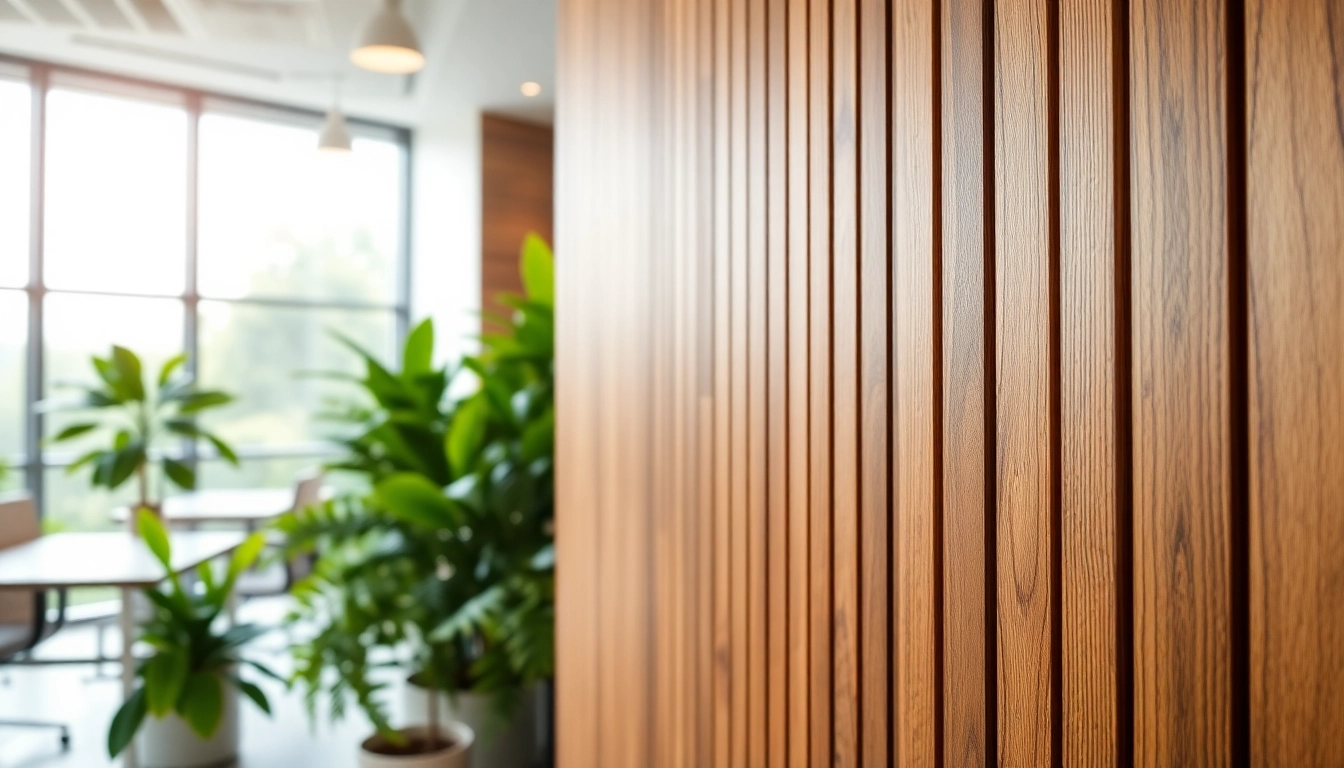Understanding Interior Paneling
What is Interior Paneling?
Interior paneling refers to the various decorative and functional materials applied to the interior walls of a building. Often seen in homes and commercial spaces, interior paneling serves multiple purposes including enhancing aesthetics, providing insulation, and improving acoustics. Historically, paneling was primarily made from wood; however, contemporary designs incorporate a magnetic range of materials such as MDF, plywood, and composite materials that can mimic the appearance of natural wood while offering greater versatility in design.
Types of Interior Paneling
Understanding the different types of interior paneling can significantly influence your design choices. Here are several popular varieties:
- Wood Paneling: Classic and timeless, wood paneling can range from traditional tongue-and-groove styles to modern board-and-batten designs.
- Plywood Panels: Offering a more industrial look, plywood is highly durable and can be stained or painted to match other decor.
- MDF Panels: Medium Density Fiberboard is an engineered product ideal for detailed designs, allowing for intricate carvings and smooth finishes.
- Acoustic Panels: Designed to absorb sound, these panels are becoming increasingly popular for both residential and commercial spaces, particularly in open-plan areas.
- Vertical or Horizontal Plank Panels: These styles can add visual interest and texture to a room, depending on their orientation.
Benefits of Using Interior Paneling
Interior paneling presents several benefits that contribute to both the functionality and aesthetics of a space:
- Aesthetic Appeal: Paneling instantly enhances the visual warmth of a room, offering a broad spectrum of colors and textures to complement any design scheme.
- Insulation: Many types of paneling improve thermal insulation, helping to maintain comfortable temperatures and lower energy costs.
- Sound Dampening: Acoustic panels specifically help reduce noise pollution in both residential and commercial spaces.
- Texture and Depth: The introduction of various materials can create depth and texture, adding dynamism to flat wall surfaces.
- Value Addition: Quality paneling can enhance property values, offering potential returns on investment in terms of aesthetics and market appeal.
Choosing the Right Interior Paneling for Your Space
Factors to Consider When Selecting Interior Paneling
Selecting the right paneling involves several crucial considerations that help maximize the design’s effectiveness:
- Space Functionality: Consider the purpose of the space. For instance, acoustic paneling may be more beneficial in home theaters or offices, while aesthetic paneling works well in living rooms or dining areas.
- Aesthetics: Match the paneling style with the existing décor or desired theme. An industrial style might benefit from raw plywood, whereas a more sophisticated look could work better with polished wood.
- Durability: If the space is subject to wear and tear, such as in children’s playrooms or high-traffic areas, opt for more robust paneling materials.
- Budget: Determine a clear budget for your paneling project. Wood paneling can be more expensive than MDF or acoustic panels, so it’s essential to know your financial limits.
- Installation: Some types of paneling are easier to install than others. DIY-friendly options like peel-and-stick panels may be better for those without professional experience.
Styling with Interior Paneling
Interior paneling can integrate seamlessly with various styles, enhancing your space’s visual aesthetics. Here’s how to style with paneling:
- Accent Walls: Use paneling to create an eye-catching feature wall that stands out from the rest of the room.
- Color Coordination: Pair paneling colors with complementary accent colors to create a cohesive look.
- Mixing Materials: Combine different materials, like wood and metal, to achieve a modern look while providing visual interest.
- Lighting: Implement strategic lighting to highlight textures and colors of paneling, creating depth in your design.
- Classic Spaces: For traditional styles, paneled wainscoting adds elegance to dining rooms and hallways.
Common Mistakes to Avoid
Avoiding common pitfalls can enhance the success of your paneling installation:
- Over-Paneling: Too much paneling can make a space feel cluttered. Ensure a balance by leaving some walls uncovered.
- Ignoring Acoustics: Not considering sound absorption can lead to noisy environments, especially in offices or media rooms.
- Improper Measurements: Always measure walls accurately before purchase to avoid unnecessary waste and costs.
- Choosing the Wrong Style: Ensure that the chosen paneling style matches the overall home aesthetic; eclectic combinations can lead to disjointed designs.
- Neglecting Maintenance: Different materials require different levels of care. Understand the needs of your chosen paneling to prolong its life.
Installation Process of Interior Paneling
Preparing Your Space for Interior Paneling
Preparing your space properly is essential for a successful paneling installation:
- Clear the Area: Remove any furniture and decorations from the walls where paneling will be installed.
- Inspect Walls: Ensure walls are clean, dry, and free from damage. This step is crucial for a smooth paneling application.
- Check Measurements: Remeasure walls to confirm your paneling needs. Measure both height and width to calculate total area accurately.
- Gathering Inspiration: Decide on the design and layout before installation to visualize the final appearance.
- Consulting Professionals: If unsure, consider consulting with a design professional to guide you through the process.
Tools and Materials Needed
Equipping yourself with the right tools and materials is fundamental for the installation process:
- Tools: Basic carpentry tools like a saw, level, measuring tape, nail gun or hammer, and a stud finder are essential.
- Materials: Choose your paneling material—be it wood, plywood, MDF, or acoustic—and gather necessary adhesives or nails for securing the panels.
- Protective Gear: Safety glasses and a dust mask can protect you from dust and debris during installation.
- Finishing Supplies: Stain, paint, or sealant as necessary to personalize and protect your chosen paneling.
Step-by-Step Installation Guide
Follow these steps to effectively install your chosen paneling:
- Mark the Studs: Use a stud finder to locate and mark the wall studs to secure the panels more effectively.
- Cut Panels to Size: Carefully measure and cut your panels according to your desired layout.
- Start Installation: Begin at one end of the wall, ensuring the first panel is level. Secure it with nails or adhesive along the studs.
- Continue Installing Panels: Work your way along the wall, fitting each new panel snugly against the previous one.
- Finishing Touches: Once all panels are installed, fill in any gaps with caulk and touch up with paint or finish as needed.
Maintenance and Care for Interior Paneling
Cleaning Tips for Interior Paneling
Proper maintenance of your paneling enhances longevity and preserves its appearance:
- Regular Dusting: Use a soft cloth or duster to remove dust regularly and prevent debris buildup.
- Gentle Cleaning Solutions: For deeper cleaning, use a mild detergent mixed with warm water and a damp cloth. Avoid harsh chemicals that might damage the finish.
- Spot Cleaning: For spills, act quickly! Blot liquid stains and apply appropriate cleaning solutions as needed.
Repairing Damage on Interior Paneling
Damage can occur over time, but many types of paneling can be repaired effectively:
- Surface Scratches: Use a matching wood filler or stain to fill in scratches or chips. For deeper gouges, sanding might be necessary.
- Replacement Panels: If a panel is too damaged, consider replacing it entirely. Contact the supplier for matching panels to ensure consistency.
- Professional Repairs: For extensive damage or complex issues, hiring a professional may be the best course of action.
Long-Term Care Best Practices
Implementing proactive care can keep your interior paneling looking pristine:
- Climate Control: Ensure your home stays at a stable temperature and humidity to prevent warping or cracking of wood panels.
- Recoat Finishes: Apply finishing coats every few years to maintain luster and protect the surface from wear.
- Seek Professional Help: Engage with professionals for significant maintenance or renovations to prevent damaging the paneling during DIY work.
Inspiration and Trends in Interior Paneling
Modern Designs Using Interior Paneling
The modern world of interior design has brought about exciting trends in paneling:
- Geometric Patterns: Incorporating geometric shapes adds contemporary flair and visual interest, moving away from traditional linear designs.
- Mixed Media: Combining wood paneling with metal or glass accents creates a chic industrial look that suits loft-style homes.
- High Gloss Finishes: For a more modern aesthetic, glossy finishes on wood or MDF panels can add depth and a touch of luxury.
Color and Texture Trends
Color and texture remain at the forefront of paneling design trends:
- Bold Colors: Oversized wall panels in bold colors can create a dramatic focal point in neutral spaces.
- Naturally Finished Wood: Natural wood finishes are gaining popularity, highlighting organic textures and sustainability.
- Textured Panels: Three-dimensional panels that play with light and shadow provide unique tactile experiences and wall dynamics.
Case Studies: Successful Uses of Interior Paneling
Examining successful implementations of interior paneling offers valuable insights:
- Residential Spaces: A recent home renovation featured wooden slat paneling around an open-concept kitchen and living area, successfully separating the two spaces while maintaining an airy feel.
- Commercial Use: An office redesign incorporated acoustic paneling throughout, significantly reducing noise levels and creating a more productive work environment.
- Renovation Projects: A historic home restoration included carefully fitted wainscoting to retain the building’s character while providing modern insulation benefits.



